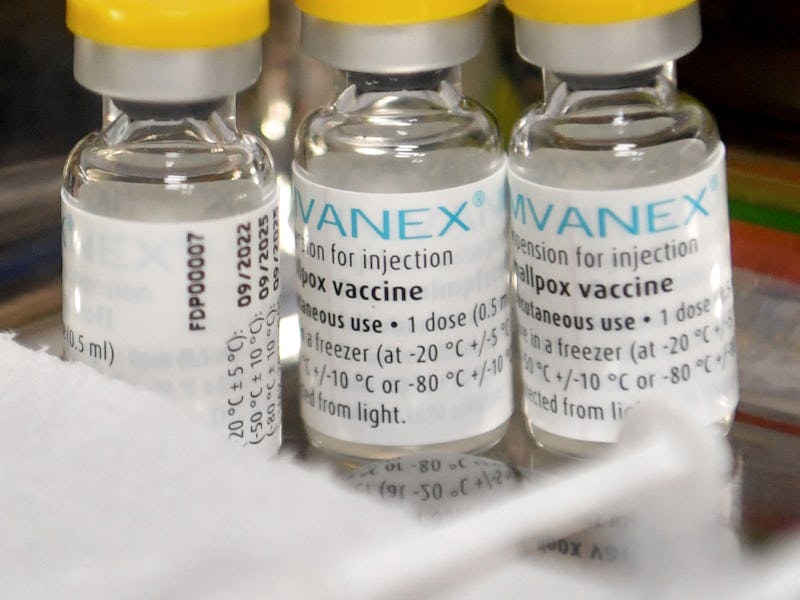Who should get the monkeypox vaccine? Here's how to find out
Certain groups should get the monkeypox vaccine — if they can find it.

As of Thursday, confirmed cases of the monkeypox virus have surpassed 10,000 in the United States. Officials have been watching outbreaks since early May when a significant number of cases began appearing outside countries where it’s endemic. Allotments of smallpox vaccines, a virus closely related to monkeypox, are being allocated from the Strategic National Stockpile — the country’s arsenal of medical supplies — to the states experiencing the highest case numbers.
Peter Hotez, Dean of the National School of Tropical Medicine at Baylor College of Medicine and Co-Director of the Texas Children’s Hospital Center for Vaccine Development tells Inverse, “We’ve learned from smallpox epidemics, that the way to do this is to do ring vaccination, in which you vaccinate as many contacts as possible.”
Many of the current cases have been found in men who have sex with men, though not exclusively. Currently, the CDC is only recommending vaccination for the following groups:
- People who have been identified by public health officials as a contact of someone with monkeypox
- People who know one of their sexual partners in the past 2 weeks has been diagnosed with monkeypox
- People who had multiple sexual partners in the past 2 weeks in an area with known monkeypox
If you meet one of these criteria, check with your local health department about availability. New York, California, and Florida are the three states that currently have the most monkeypox cases. New York links to all city and county health departments here. California offers guidance for local health departments about vaccine eligibility here. In Florida, people can find their local health department through this portal.
If you don’t fall into any of these groups, you currently won’t be able to get vaccinated and it's also likely that right now your risk of getting monkeypox is lower than those who do fall into one of these groups. However, things can shift quickly when it comes to infectious diseases. The CDC will continue to monitor both the number of cases of monkeypox and how these cases spread and may include more groups for vaccination.
Because it was developed for smallpox and thus clinical trials evaluated efficacy against that virus, we don’t have a concrete, precise number for how effective the smallpox vaccines are at preventing monkeypox infection. A study conducted in the Democratic Republic of the Congo (then called Zaire), between 1981 and 1986 found that the smallpox vaccine was 86 percent effective against infection from monkeypox, though it was a small study with two major caveats for the current outbreak: The smallpox vaccine used in the 1980s was different than current smallpox vaccines. And, the monkeypox virus has mutated over those four decades.
People waiting in line to get the Monkeypox virus vaccine at St. John's Well Child & Family Center on August 10, 2022 in Los Angeles, CA.
CDC data show that between May 17 and July 22nd, “among 954 persons with hospitalization data available, 77 (8 percent) patients were hospitalized because of their illness.” As of now, no deaths have been reported in the United States.
Norman Beatty, an Assistant Professor of Medicine at the University of Florida College of Medicine, and infectious disease specialist tells Inverse that the JYNNEOS smallpox vaccine is FDA approved for the “prevention of both smallpox and monkeypox viral infections in those who are 18 years of age and older,” adding that it is “currently under Emergency Use Authorization for those who are less than 18 years old” who are deemed to be at high risk of contracting the virus.
However, supplies of the vaccine are limited and not everyone who meets the criteria will be able to obtain one. U.S. health officials authorized a plan on Tuesday to stretch the supply of the JYNNEOS smallpox vaccine further by giving a fifth of the normal dose. Fractional dosing, Hotez explains, is when a smaller amount of the vaccine is given subcutaneously — just under the skin — as opposed to intramuscularly. This is thought to elicit a faster immune response and would allow more people to be vaccinated with limited supplies.
White House officials said the fractional dosing would immediately multiply the 440,000 currently available as full doses into more than 2 million smaller doses. Even with fractional dosing, the complete course of the vaccine still requires two shots, spaced four weeks apart.
A second vaccine, ACAM2000, was approved in 2007 for people at high risk of smallpox. There is some evidence that it may be effective against monkeypox as well, though that has been less well studied. The limited supply of JYNNEOS vaccine is putting pressure on the Biden administration to help meet the demand.
The CDC notes that “ACAM2000 is a single-dose vaccine, and it takes four weeks after vaccination for its immune protection to reach its maximum. However, it has the potential for more side effects and adverse events than JYNNEOS. It is not recommended for people with severely weakened immune systems and several other conditions.”